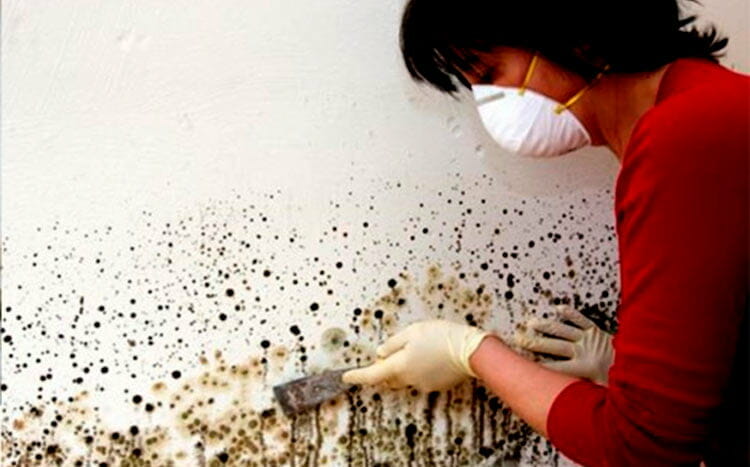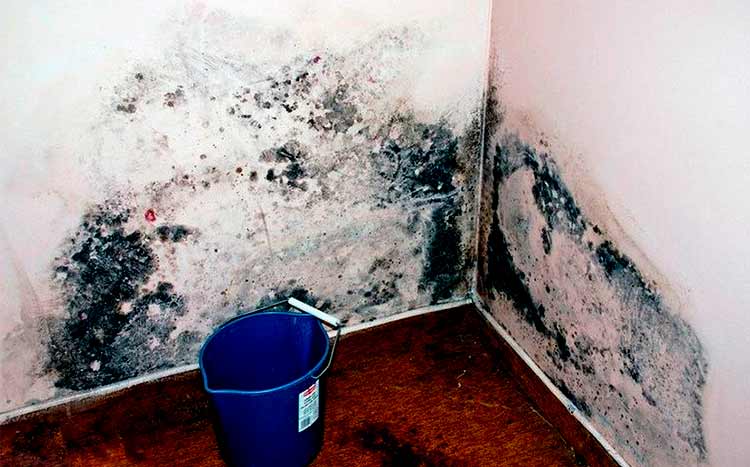It’s typical to find mold in dark, damp, or humid areas, like bathrooms, basements, and inside drywall, particularly in older or unoccupied homes. These environments provide ideal conditions for mold to thrive. What happens to mold when there’s a decrease in humidity levels for a period? Will it diminish or perish?
Mold will dry out but stay dormant if the area it is growing does not have moisture like any other living fungi. However, it does not mean the same mold won’t start spreading again and developing new spores when conditions change. At the same time, there is no evidence that dry mold spores are harmless to people if inhaled for long periods.
Will Mold Die If It Dries Out?
Mold will dry out if the conditions on the surfaces it was growing on change, depriving it of water and nutrients but it will not die out. Instead, the mold spores simply become dormant just like any living fungi or plant, and start spreading when conditions are favorable (moisture and organic matter).
For instance, some molds will dry out in the summer if they appear as a result of humidity or a leaking wall but will start spreading in the spring. You’ve probably noticed a sharp increase in allergic reactions associated with breathing in spring if you live in an old or rarely used vacation home. This could be as a result of an increase in mold spores spreading, breaking off, and getting into the air circulation or AC ducts.
Common types of mold that are found in homes such as Alternaria and Aspergillus also remain toxic and release spores as light powdery particles when they dry out as a way to spread akin to pollination in plants. These dry spores are still toxic therefore dangerous to you and your loved ones especially those with lung-related conditions such as asthma and allergic to dust or pollen.
The only sure and safest way to deal with mold is to have it removed completely by a certified mold expert. Leaving it to dry out by depriving it of moisture or fixing leaks is not a solution. Dry mold spores also make your paintwork peel and look nasty if left undisturbed for long periods even after drying out.
At What Humidity Does Mold Die?
Common house mold varieties such as Stachybotrys Atra (black mold), Alternaria, and Aspergillus are pretty resilient and can survive on very little moisture and nutrients because of their size. There will need to be little to no humidity and nutrients for an extended period for them to dry out and go into dormancy.
Keep in mind that mold spores are microscopic strings less than a millimeter-thick meaning even a tiny amount of moisture is enough to keep them alive. This is why mold will quickly spring back to life and regrow new colonies as soon as humidity levels increase, releasing millions of spores into the air.
How Long Does It Take for Mold to Die Without Moisture?
Mold will dry and its spores become dormant after a fortnight or so without moisture. Other mold types may stay for longer (months) If they have a water retention mechanism in their structure. For instance, it is quite common to find mold growing and spreading in an old house in the summer with barely any moisture. While the mold might appear dead after a few days, the spores are usually quite alive and potent.
Another factor to keep in mind is the water retention capabilities of the surface the mold is growing. For instance, concrete surfaces, drywall, and wood surfaces tend to retain water for long periods. This means the mold will continue thriving and developing new colonies even after the source of moisture is fixed. Ideally, mold should be cleaned out immediately when it is discovered and the surfaces treated with anti-mold chemicals as a preventive measure.

What Happens to Mold When It Dries Out?
The mold’s core structure usually dies or becomes dormant when it dries out. However, this depends on the type of mold and its anatomy. Some mold types will die out completely and break off while others become dormant and appear like stains on the surface. The string-like spores, however, usually remain dormant and may break off and poison the air circulation when they dry out.
In the case that the mold spores become dormant, they will start breaking off and spreading as soon as there is a bit of moisture. Some of them might get blown off or break off and become the toxic dust that usually causes problems to occupants.
Are Dry Mold Spores Harmful?
Dry mold spores from common toxic mold types such as Stachybotrys Atra (black mold) are quite harmful to human and household pets if inhaled. There is no evidence that their toxicity levels reduce or change when they are dry. Dry mold spores can cause a whole range of issue and trigger health conditions in humans once they get into the respiratory system among them:
- Uncontrolled coughing and sneezing
- Allergic reaction
- Difficulty breathing
- Respiratory illness
- Exacerbating lung-related illness
- Lung cancer for rare and prolonged exposure in some individuals, etc.
The CDC states that exposure to mold spores can trigger unspecified respiratory symptoms in humans and recommends that it be cleaned off as soon as it is discovered. As mentioned earlier, dry mold spores also tend to break off more easily and form a cloud of fine toxic dust that spread quickly in the air circulation especially if disturbed by a fan or AC.
Does Dried Mold Need to Be Removed?
Dry mold should be removed as soon as it is discovered to avoid future growth and contamination. Dry mold is in a non-viable or dormant state and, as discussed earlier, still quite harmful to you and your loved ones.
However, you should not make the mistake of wiping off or using a scalpel to scrape off the dried mold. Doing so will just cause the weakened mold spores to break off and spread to other areas. Have a certified mold expert inspect the mold, recommend a removal plan and have it removed safely. Later you can identify the source of moisture and fix it as a preventive measure.
Will Mold Go Away If You Remove Moisture?
Removing moisture does not cause the mold to disappear or die. Instead, common household mold goes into a dormant state and will regrow when conditions are right. You will still be able to see the dry, non-viable mold on the surface it is growing on or smell it in the air. Dry, dormant mold may have an earthy or pungent smell depending on the species. Keep in mind that dormant or dry mold is still harmful.
Removing moisture is one of the ways you can prevent further growth as you wait for the mold removal crew or after the cleanup as a preventive method. You can get rid of excess moisture by:
- Ensuring there is proper ventilation
- Fixing broken drainage pipes
- Fixing leaks and other sources of moisture
- Repainting with mold and moisture-resistant paint
- Fixing leaking roofs and window seals, etc.
Getting rid of moisture prevents mold from germinating and thriving in your house. This is because mold requires moisture in addition to organic material(cellulose) to survive and spread.
DIY Vs. Calling A Professional
Do you have mold in your house? You can decide to hire a mold removal or remediation service to inspect and clean it out professionally or choose to remove it yourself if you know how to. Both approaches have their advantages and risks such as:
Do it Yourself
Pros
- You can inspect and remove the mold at your time even after hours. Professional mold services only work on normal working hours and have a fixed schedule.
- It is cheaper because you don’t have to pay for the mold removal service.
Cons
- Inspecting and removing mold is a complex exercise. You will need to do a lot of research and preparation to know how to properly remove mold especially if it is the toxic type.
- You won’t have access to professional inspection and removal tools such as infrared cameras and air samplers that professionals use in their trade.
Calling a Professional
Pros
- Access to experienced and trained mold experts means you can get rid of the mold problem completely.
- Professionals use sophisticated inspection and mold removal tools that you may not have access to.
- Safety- there is less risk of contamination when you hire a professional.
- Certified mold experts can create a mold removal certificate or inspection document that can be used as a legal document in a house sale.
Cons
- Professionals charge a fee to remove mold. However, it is worth it given that they will get rid of the mold so you don’t have to worry about it.
- Your best option if you have a mold problem is to find and hire a local mold removal service to inspect and remove the mold. You can use our free tool to find top-rated mold experts in your zip code by following these steps:
- Scroll to the top of the page and enter your Zipcode
- Answer questions about what you want to be done
- The information you enter will be forwarded to three mold experts. They will send you a price estimate for the job and some friendly advice
IMPORTANT: There is no obligation to hire. This is a free tool and service to be used at your pleasure.
FAQ's
How Long Does It Take for Mold to Affect You?
Mold affects you in different ways. Some people will have immediate reactions such as coughing, sneezing, allergic reactions, or difficulty breathing especially if they have underlying respiratory illnesses such as asthma or lung cancer. Prolonged mold exposure can cause more serious health conditions such as lung disease too.
What Do Dried Mold Spores Look Like?
Dry mold spores look like strings, hair-like structures, or stains depending on the size and species of mold. Most of them break off and become invisible dust.
What Can You Use to Kill Mold?
You can use off-the-shelf mold removal chemicals or mold bombs to kill mold. Mold experts use a range of chemicals and tools to remove and kill mold. You should not use bleach or household detergents to clean mold.








